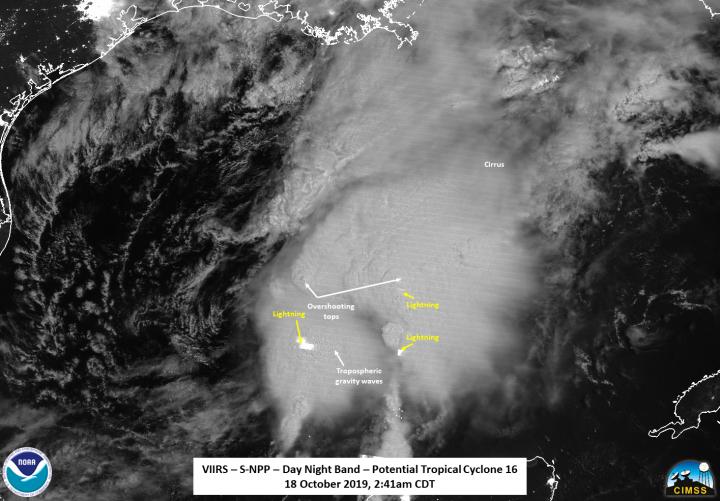
Credit: Credit: NASA/NOAA/UWM-CIMSS, William Straka III
NASA-NOAA’s Suomi NPP satellite provided night-time and infrared views of developing Tropical Storm Nestor in the Gulf of Mexico and found over-shooting cloud tops and gravity waves. When the satellite passed over the potential tropical depression early on Oct. 18, it was consolidating. Less than 12 hours later, it became a tropical storm.
The Visible Infrared Imaging Radiometer Suite (VIIRS) instrument aboard Suomi NPP provided a night-time and an infrared image of the storm.
Night-time Imagery of Nestor: Overshooting Tops, Gravity Waves
The night-time image was captured on Oct. 18 at 3:41 a.m. EDT and revealed lightning, overshooting cloud tops into the stratosphere and gravity waves. An overshooting cloud top is a dome-like protrusion above a cumulonimbus anvil cloud, often penetrating into the lower stratosphere. It indicates a very strong updraft in the convective cloud or thunderstorm.
Gravity waves are the mark of a powerful storm. They are created when air moving around the atmosphere gets pushed to another place as in the case of tropical cyclones. Powerful thunderstorms around a tropical cyclone’s center can move air up and down and generate these waves in quick, short bursts. They can be seen as ripples in some imagery of clouds in a tropical cyclone.
Infrared Imagery Shows Very Cold Cloud Tops
The infrared imagery captured by Suomi NPP’s VIIRS instrument on Oct. 18 at 3:41 a.m. EDT showed powerful thunderstorms with cloud tops colder than minus 112 degrees Fahrenheit (minus 80 degrees Celsius) within the eastern part of the storm.
Visible satellite imagery and data from an Air Force Reserve Hurricane Hunter aircraft also showed a rather large and elongated surface circulation.
Warnings and Watches
NOAA’s National Hurricane Center or NHC said a Tropical Storm Warning is in effect from the Mississippi/Alabama border to Yankeetown, Florida and from Grand Isle, Louisiana to the Mouth of the Pearl River. A Storm Surge Warning is in effect from Indian Pass, Florida to Clearwater Beach, Florida.
Nestor’s Status on October 18, 2019
At 2 p.m. EDT (1800 UTC), the center of Tropical Storm Nestor was located near latitude 26.3 degrees north and longitude 89.5 degrees west. That is 195 miles (315 km) south of the mouth of the Mississippi River. Nestor is moving toward the northeast near 22 mph (35 kph), and this general motion is expected to continue through Sunday, followed by a turn toward the east-northeast by early Monday. Maximum sustained winds are near 60 mph (95 kph) with higher gusts. Some strengthening is expected later today, with weakening forecast after Nestor moves inland. Nestor is expected to lose tropical characteristics and become post-tropical on Saturday. The estimated minimum central pressure is 1001 millibars.
Nestor’s Forecast
The National Hurricane Center forecast calls for the center of Nestor to approach the northern Gulf Coast later on Oct. 18 and move inland across portions of the southeastern United States Saturday and Sunday as it becomes a post-tropical cyclone. Nestor is expected to move offshore of the coast of North Carolina into the western Atlantic by late Sunday.
Hurricanes are the most powerful weather event on Earth. NASA’s expertise in space and scientific exploration contributes to essential services provided to the American people by other federal agencies, such as hurricane weather forecasting.
For updated forecasts. Visit: http://www.
By Rob Gutro
NASA’s Goddard Space Flight Center
###
Media Contact
Rob Gutro
[email protected]
Original Source
https:/




